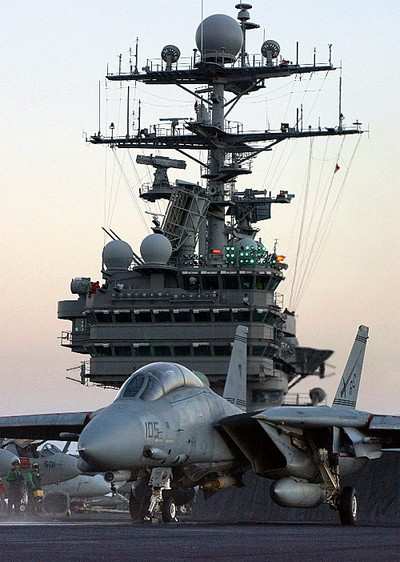Reelin’ In the Years—and the Tactical Aircraft
Laid down in 1968 and launched in 1972, the USS Nimitz (CVN-68), is the oldest active aircraft carrier in the U.S. Navy’s carrier fleet and, in point of fact, the world’s oldest such vessel.

On 24 April 2023, the Navy reported the storied ship—which takes its name from World War II U.S. Navy Pacific fleet commander Chester W. Nimitz and makes its home port at Washington State’s Naval Station Everett—had logged its 350,000th aircraft trap—a milestone unique in the annals of naval history.
The historic trap was made on the South China Sea by an F/A-18F Super Hornet piloted by Captain Craig Sicola, the Nimitz’s commanding officer who remarked: “I dedicate this landing to the countless naval aviators who have flown before me.”
Captain Sicola was joined in the history-making F-18 by Wizzo (Weapon Systems Officer/WSO) Commander Luke Edwards, commanding officer of Strike Fighter Squadron 22, known as the Fighting Redcocks. Both men are longtime Naval Aviators.
In the argot of the U.S. Navy, the term trap denotes an arrested carrier landing—an inherently rowdy and rough maneuver in which a landing fixed-wing aircraft touches down on an aircraft carrier’s flight-deck and its tailhook—deployed by the pilot during the approach procedure—snags one of the ship’s four arresting cables. Thus trapped, the aircraft is violently but effectively slowed to a safe speed by the arresting cable, which is let out by a complex mechanical system calibrated to provide sufficient resistance to stop the aircraft but not tear it asunder or snap its pilot’s neck.
Arrested landings are necessary insomuch as Naval fixed-wing aircraft cannot safely land and stop in the length of an aircraft carrier’s flight-deck. Endeavoring to land an F-18 on an aircraft carrier in the absence of a tailhook and arresting cables is the most expedient means by which to convert jet to jetsam.
Commissioned in May 1975, the Nimitz is the lead ship of the U.S. Navy’s Nimitz-class of aircraft carriers. The vessel is part of the Navy’s 3rd Fleet’s Carrier Strike Group 11. Currently, the Nimitz is on a regularly scheduled deployment in the South China Sea’s 7th Fleet area of operations.

U.S. Navy Rear Admiral Christopher Sweeney, commander of Carrier Strike Group 11, stated: “As we sail through the South China Sea, we celebrate this once-in-a-lifetime achievement, 350,000 arrested landings, over a hundred years of innovation in the U.S. aircraft carrier. This landmark is a testament to the nation's commitment to fly, sail, and operate around the globe promoting peace and security.”
Since entering into U.S. Naval service, the Nimitz has sailed thirty deployments and served in myriad operations. The great ship is slated to be retired in 2027—59-years after her keel was laid down at Virginia’s Newport News shipbuilding facility. Upon her eventual decommissioning, the Nimitz will return to Newport News, one of only two U.S. installations capable of safely securing and dismantling her two Westinghouse A4W class nuclear reactors.
In the hierarchy of arrested landings, the Nimitz is trailed closely by the Navy’s second-oldest active carrier, the USS Dwight D. Eisenhower, which has logged approximately 327,000 traps.
 Airborne-Flight Training 05.09.24: ERAU at AIAA, LIFT Diamond Buy, Epic A&P
Airborne-Flight Training 05.09.24: ERAU at AIAA, LIFT Diamond Buy, Epic A&P ANN's Daily Aero-Term (05.07.24): Hazardous Weather Information
ANN's Daily Aero-Term (05.07.24): Hazardous Weather Information Aero-News: Quote of the Day (05.07.24)
Aero-News: Quote of the Day (05.07.24) NTSB Final Report: Cessna 150
NTSB Final Report: Cessna 150 Aero-News: Quote of the Day (05.08.24)
Aero-News: Quote of the Day (05.08.24)




